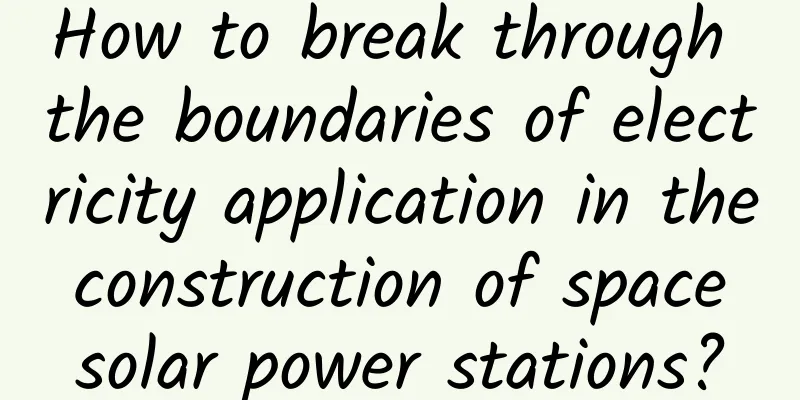How to break through the boundaries of electricity application in the construction of space solar power stations?

|
What is a space solar power station? Why do we need to build a solar power station in space? How do we build a space solar power station? The prospects are very bright At present, solar power generation on the ground is very popular, mainly using solar panels to convert solar energy into electrical energy. Now, scientists want to build solar power stations in space. In fact, using solar power to generate electricity in space is not new, because most artificial earth satellites, manned spacecraft and space probes are equipped with large and small solar panels, including the Chang'e 4 lunar probe that just landed on the back of the moon. However, the electricity generated by the solar panels of these spacecrafts is for the spacecraft itself, while the electricity generated by the solar power station that scientists want to build in space will be mainly used by thousands of households on the ground, providing huge clean energy for mankind. Conceptual image of a tower-type space solar power station consisting of a large number of solar cell arrays Renewable clean energy is the main material basis for the survival and sustainable development of human society. However, new energy sources such as ground solar energy, wind energy, hydropower, nuclear energy, ocean energy, geothermal energy and bioenergy all have problems such as limited total amount and instability, and it is difficult to replace the status of traditional fossil energy on a large scale. The sun is the inexhaustible core energy system of the earth and the entire solar system, but its utilization rate on the ground is not high. This is because the use of solar energy on the ground will be greatly attenuated by the absorption and scattering of the atmosphere, clouds and rain, and the alternation of seasons and day and night. The energy density also changes greatly and is very unstable. However, there is a lot of solar energy in space. For example, in geosynchronous orbit, since the sun's rays are not weakened by the atmosphere and the shadow period is very short, its intensity is more than 6 times that of the ground, and it is possible to achieve fixed-point transmission of energy from space to the ground. Therefore, building solar power stations in space can effectively utilize the solar energy in this orbit and provide humans with high-quality, huge and inexhaustible clean energy. Tethered solar power station solution Compared with wind power and hydropower, space solar power stations are not affected by natural factors such as weather and regional latitude. They can collect, convert and utilize solar energy on a large scale, and their power generation is comparable to that of ground-based nuclear power stations. Moreover, their electric energy is transmitted wirelessly, which can provide directional or mobile power supply to remote areas, disaster-stricken areas and important facilities. Its extended wireless energy transmission, wireless communication and other related technologies can be widely used in military and civilian fields. It is reported that if a solar power station is launched into a geosynchronous orbit 36,000 kilometers away from the earth, its energy efficiency will be 35 times that of ground-based photovoltaic power stations. The development of space solar power stations can provide commercial, large-scale electricity supply for the ground, solving the long-term demand for stable renewable energy. At the same time, space solar power stations have important application prospects in power supply to remote areas on the ground, emergency power supply, spacecraft power supply and environmental regulation. At the same time, the development of space solar power stations will also lay the foundation for the long-term development of lunar solar power stations. Once we can master the space solar power generation technology, we will hopefully gradually solve the energy crisis facing human society and obtain inexhaustible sustainable clean energy. Therefore, space solar power stations are called "the great revolution in the energy field", and experts from China, the United States, Japan and other countries are actively conducting related research. One of Japan's space solar power station plans Three major components Space solar power station refers to a power system that converts solar energy into electrical energy in space and then transmits it to the ground through wireless energy transmission. It is an important means of developing and utilizing space resources, and mainly includes three parts: solar power generation equipment, energy conversion and transmission equipment, and ground receiving and conversion equipment. Schematic diagram of the composition of the space solar power station system The solar power generation device converts solar energy into electrical energy; the energy conversion device converts electrical energy into microwaves or lasers (lasers can also be directly converted from solar energy), and uses the transmitting device to send beams to the ground; the ground receiving system receives the beams transmitted from space, converts them into electrical energy through the conversion device and connects them to the power grid. The entire process will go through the energy conversion process of solar energy-electrical energy-microwave (laser)-electrical energy, or solar energy-laser-electrical energy. Current research shows that the ideal orbit for space solar power stations should be the geosynchronous orbit, 36,000 kilometers above the earth. The geosynchronous orbit is stationary relative to the ground and close to the earth. It can stably receive solar radiation 99% of the time and transmit energy to fixed areas on the ground. It is relatively convenient to control and transmit electrical energy, and it can be transmitted at any time. There are no major problems with the technical principles of space solar power stations. In recent years, great progress has been made in solar power generation efficiency, microwave conversion efficiency and related aerospace technologies, laying a good foundation for the development of future space solar power stations. However, as a very large space system, space solar power stations require systematic research and breakthroughs in many technical aspects. For example, to meet industrial application standards, the power generation requirements will be very high, at least in the megawatt level, and solar panels may also be calculated in square kilometers. As of now, space solar power stations are the most direct, effective and feasible way to develop the Earth-Moon space economic circle, and are much easier than developing lunar helium-3. Several typical solutions Space solar power stations need to solve three key problems: first, how to transport power generation equipment to geosynchronous orbit and assemble it for power generation through large launch vehicles; second, how to transmit electricity to the ground; and third, how to ensure the safety of equipment operation and environmental safety. At present, these three problems are still in the basic exploration stage. At present, experts in some countries have proposed a variety of space solar power station schemes, each of which has its own advantages and has a high reference value for the design of practical space solar power stations in the future. For example: the integrated symmetrical concentrating system design scheme. This scheme uses large clamshell concentrators on both sides of the mast to reflect solar energy to two photovoltaic arrays located in the center. The concentrator faces the sun, and the mast, battery array, and transmitting array rotate as a whole to the ground. The concentrator and the mast rotate with each other to maintain daily orbital changes and seasonal changes. Conceptual image of a space solar power station with an integrated symmetrical concentrating system Arbitrary phased array design. The core idea of this scheme is still the concentrated space solar power station. The important thing is that it adopts a modular design concept and innovatively proposes the concept of a control-free concentrating system (the effectiveness of this concentrating system needs further analysis), which greatly reduces the pressure on the control system. The mass of the entire system is about 10,000 to 12,000 tons. Arbitrary Phased Array Space Power Station Laser space solar power station is another important direction of the concept of space solar power station. It uses solar concentrators (such as parabolic) or lenses (such as Fresnel) to focus sunlight with a high concentration ratio, and sends the concentrated sunlight to the laser generator, which uses direct pumping laser to generate laser. The laser is expanded and transmitted to the ground, where it can be received and converted into electricity by specific photovoltaic cells, or directly used for hydrogen production. So far, the largest object launched into space by humans, the International Space Station, weighs more than 400 tons, while an industrial-grade solar power station weighs thousands of tons. It is almost impossible to build a space solar power station by launching it from the ground. Therefore, some experts have proposed that the most important component of solar power generation is the solar panel, whose raw material is silicon dioxide, which is an inexhaustible resource that can be found everywhere on the moon; there is water on the lunar poles and asteroids in the cis-lunar space, which can be electrolyzed into oxygen and hydrogen as propellants for spacecraft. These two conditions combined make it possible to build a solar power station in the cis-lunar space. Some experts in my country have suggested that the construction materials of space solar power stations be launched directly into space, and a "space factory" be built in space to print out the required components through 3D technology and then assemble them using space robots. This is one of the current research directions. Facing huge challenges Space solar power stations are huge in scale, with a mass of up to 10,000 tons, a size of 1,000 meters, a power generation capacity of megawatts, and a lifespan of more than 30 years. Therefore, they pose great technical challenges to new types of transportation, new materials, high-efficiency energy conversion devices, ultra-large spacecraft structures and control technologies, and in-orbit assembly and maintenance technologies. Cost is the main factor restricting the development of space solar power stations. Scaling and industrialization pose huge challenges to the existing spacecraft manufacturing and launch capabilities, and will require fundamental changes in the existing aerospace industry production system. The safety of long-term operation is also an issue that requires special attention. Although the power of space solar power stations is very large, if the microwave energy transmission mode is adopted, due to the long distance, according to the characteristics of microwave transmission, the energy density of the actual receiving antenna is low. Although the beam density has been limited to meet safety requirements from the perspective of system design, the impact of long-term microwave radiation on the ecology, atmosphere, organisms, etc. still requires long-term research. The core issue of the development of space solar power stations is to reduce the system area. Its area is mainly determined by two parts. One is the area of the solar power generation part, that is, the area of the solar cell array or the concentrator area. Regardless of whether the form of concentration is adopted, improving the photoelectric conversion efficiency of solar cells is the most effective measure to reduce the area of the solar power generation part. The second is the area of the microwave transmitting antenna. Under the selected orbit and microwave frequency, the area of the microwave transmitting antenna is inversely proportional to the ground receiving area, and the area of the transmitting antenna needs to be optimized. Concentrated Space Solar Power Station Solution In addition, it is also important to reduce the quality of the system, reduce the volume of the system, and address the technical and safety aspects of the transmission channel. China's space solar power station construction roadmap China attaches great importance to the development of space solar power stations. In 2008, my country included the research and development of space solar power stations into the national preliminary research plan. Since the 12th Five-Year Plan, the number of domestic research teams involved in space solar power stations has gradually expanded. The State Administration of Science, Technology and Industry for National Defense has supported the overall and key technology research related to space solar power stations. At present, it has achieved certain results in overall planning, overall concept scheme, microwave wireless energy transmission technology, etc., and has also driven the development of large-scale space structures and space thin-film solar power generation technology. The research team of Qian Xuesen Space Technology Laboratory of China Academy of Space Technology compared various space power station schemes at home and abroad, focused on the study of non-concentrating and quadratically symmetrical concentrating space solar power stations, and proposed an innovative multi-rotating joint space solar power station (MR-SSPS) scheme. This scheme decomposes the solar cell array into multiple cell sub-arrays, and transforms the single conductive rotating joint of the traditional non-concentrating solar power station into multiple smaller power conductive rotating joints, which not only solves the technical problems of extremely high power conductive rotating joints and single point failures, but also makes it easier to assemble and build the system. This scheme has been recognized by top international experts in this field and won the first place in the 2015 World Solar Satellite Design Competition. my country has also made significant progress in key technologies such as wireless energy transmission. Wireless energy transmission includes two methods: microwave and laser. At present, the research focuses on microwave methods. The main research directions include: improving the efficiency, life and power-to-weight ratio of microwave sources, optimizing the power distribution on large-diameter antennas to achieve efficient microwave power synthesis, considering the influence of factors such as the configuration of the entire structure and the real-time shape and position state on the beam pointing in high-precision beam control, and developing integrated ultra-light antenna modules from the perspective of electromechanical and thermal integration. The space solar power station is a grand project that involves many important technical fields such as space transportation, attitude control, microwave technology, energy transmission, etc. Each key technology requires an effective, safe and reliable simulation verification plan. The experimental base will play a role in simulation verification and demonstration. At present, my country has initially achieved a transformation from "following" to "running side by side" in the research of space solar power stations, becoming an important force in promoting the development of space solar power stations internationally. Chinese experts have proposed a technical roadmap for achieving my country's space solar power station goals: building a megawatt-class experimental space solar power station after 2030 and a gigawatt-class commercial space solar power station after 2050. |
<<: Is weight loss chocolate a "tax on IQ" or is it true?
>>: Drink more water when you have a cold and fever. What kind of water should you drink?
Recommend
Whole wheat bread mixed with "bran" in the flour? Experts: Bran and bran are not the same substance
"Wholemeal bread is made by mixing bran, als...
The number of new confirmed cases in Hubei has dropped to single digits for the first time!
8 cases! #The number of newly confirmed cases in ...
Understand at a glance: The correct way to use express delivery and takeout during the epidemic!
Recently, with the spread of the epidemic and the...
How many days does it take for the cough to turn into white lungs? On which day should a CT scan be done? If you have these signs, go to the hospital immediately →
In just one week, the 8-year-old girl developed a...
The peak season for flying catkins has arrived! Quickly collect the protection guide for children
April is the time when spring flowers bloom and w...
Want to reduce microplastics in water? Boil it before drinking丨Tech Weekly
Compiled by Zhou Shuyi This fish is only the size...
What should I do if the Baidu search resource platform prompts that the DNS cannot resolve the IP?
When performing crawl diagnosis on Baidu Search R...
Practical Tips | Teach you how to write a product experience report that will make HR scream (taking Baidu Maps as an example)
During the job search process, a complete product...
What exactly is Google's Ara project?
[51CTO Translation] Modular mobile phones, which ...
A big bet: A detailed analysis of the 2.3 billion "bet" between LeEco and "The Great Wall"
Two years after Coming Home, director Zhang Yimou...
A brief discussion on the deep learning technology behind AlphaGo
Introduction: There are many comments on Alfa Go,...
Apple iOS 9 may integrate smart home applications
Beijing time, May 21 morning news, American techn...
Cars without drivers? How AGI can “get rid of” humans from autonomous driving
[Editor's Note] The emergence of ChatGPT and ...
Challenging MOTO 360? Geak Watch II is more than just a round watch face
In today's smart technology industry, various...









